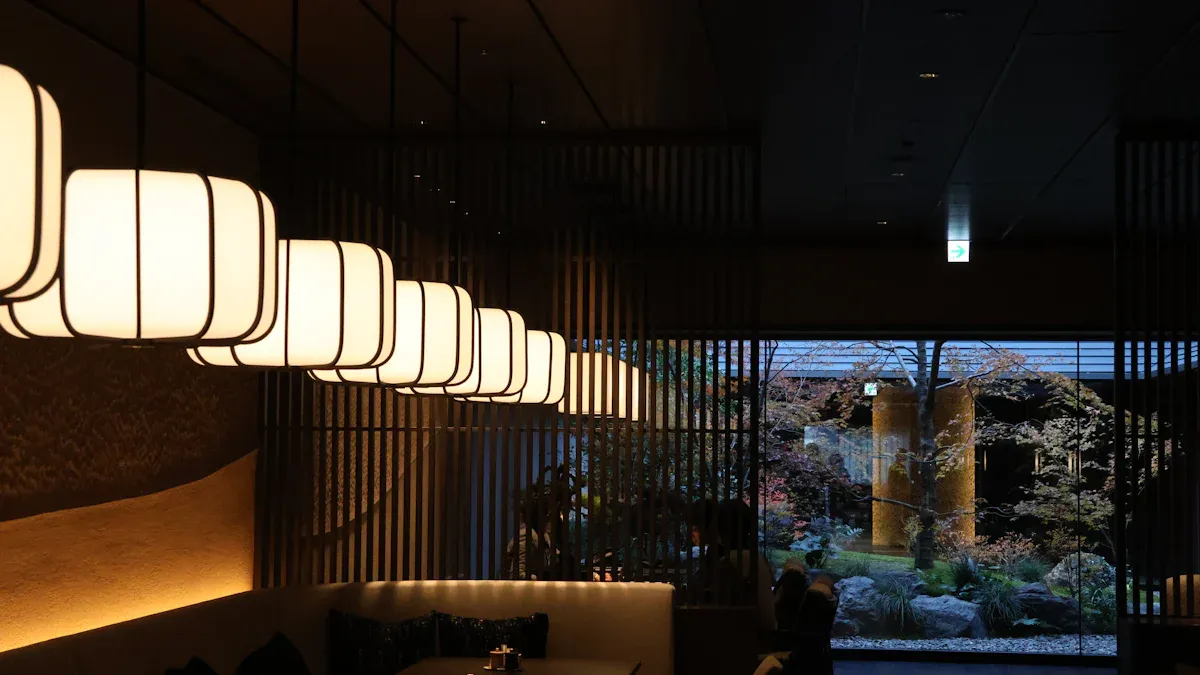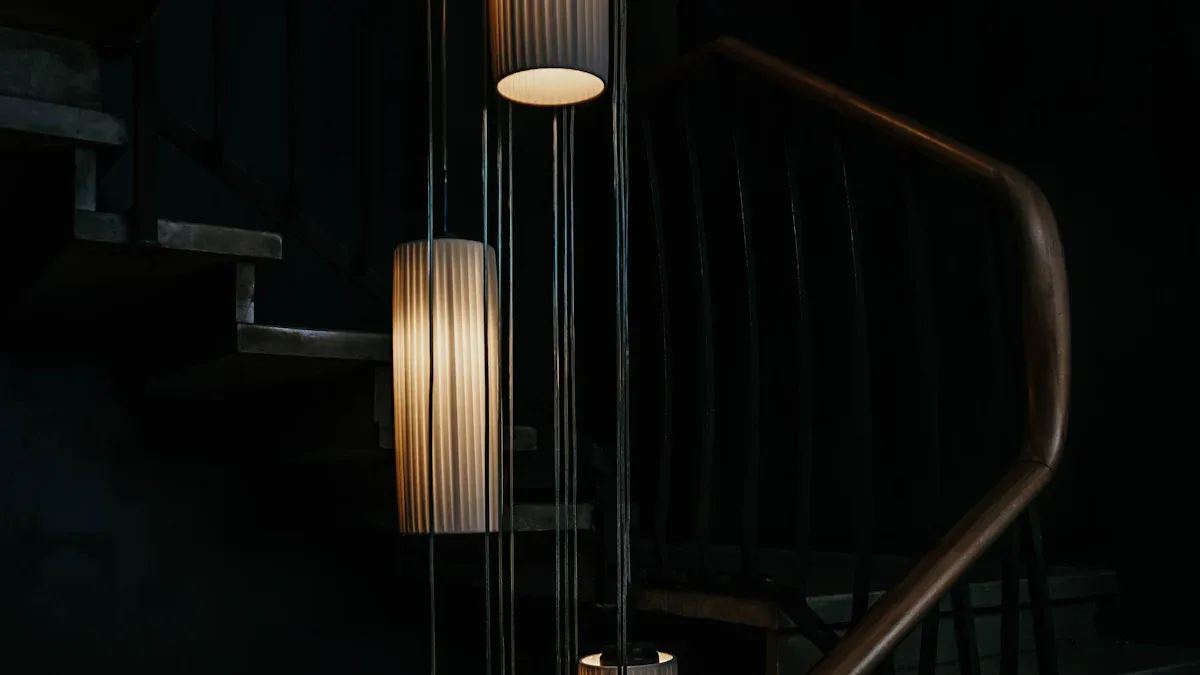
How Lighting Transforms Interior Spaces: A Designer’s Perspective

Lighting plays a pivotal role in shaping your interior spaces. It sets the mood, enhances functionality, and elevates the overall aesthetic. From creating a cozy ambiance to highlighting architectural features, the right light transforms your home into a personalized haven. Custom curtains provide essential light control, helping you fine-tune brightness while adding a touch of elegance to your decor.
Key Takeaways
Lighting changes how a room feels. Warm lights make living spaces cozy, while cool lights help you focus in work areas.
Make lighting useful. Task lights help you work better and protect your eyes, making daily tasks simpler and more fun.
Using layers of curtains helps control light and look nice. Mix sheer and blackout curtains to change brightness and make your room prettier.
The Impact of Lighting on Interior Design

Shaping Mood and Atmosphere
Lighting has a profound effect on how you feel in a space. The right light can create a sense of calm, energy, or even intimacy, depending on its intensity and color. For example, warm lighting often evokes feelings of comfort and relaxation, making it ideal for living rooms or bedrooms. On the other hand, cooler tones can boost focus and alertness, which is why they are commonly used in workspaces.
Studies have shown that lighting conditions significantly influence mood. In one study involving 988 participants, researchers found that mood improved when lighting was balanced—not too dim or overly bright. Interestingly, the color design of a room also played a role in enhancing positivity. This means that by carefully selecting your lighting and pairing it with complementary colors, you can create an environment that uplifts your spirits and aligns with your daily needs.
Enhancing Functionality in Everyday Spaces
Lighting is not just about aesthetics; it also plays a critical role in how you use a space. Properly optimized lighting can make tasks easier and improve your overall well-being. For instance, task lighting, such as desk lamps or under-cabinet lights, provides focused illumination for activities like reading, cooking, or working. This ensures that you can perform these tasks efficiently without straining your eyes.
The benefits of well-designed lighting extend beyond convenience. Research highlights measurable improvements in functionality when lighting is optimized. Productivity can increase by up to 16%, while work accuracy improves by 12%. Additionally, circadian lighting—designed to mimic natural daylight—has been shown to enhance sleep quality for 25% of employees. These findings underscore the importance of choosing the right lighting solutions for your home or office.
Elevating Aesthetic Appeal
Lighting is a powerful tool for enhancing the visual appeal of your interiors. It highlights architectural features, draws attention to artwork, and creates depth and dimension in a room. For example, accent lighting, such as wall sconces or spotlights, can emphasize a textured wall or a statement piece of furniture. Ambient lighting, on the other hand, sets the overall tone of a space, ensuring that it feels cohesive and inviting.
To understand how lighting transforms aesthetics, consider its impact in different settings. In fine dining restaurants, warm, high-contrast lighting enhances intimacy and elevates the dining experience. In contrast, fast-food establishments use bright, even lighting to accommodate high traffic and encourage quick turnover. These examples illustrate how lighting choices can shape not only the look of a space but also how it is experienced.
By experimenting with various lighting techniques, you can bring out the best in your interiors. Whether you want to create a cozy retreat or a vibrant social hub, the right lighting will help you achieve your vision while staying on trend with the latest interior design trends.
Exploring Types of Lighting

Ambient Lighting: The Foundation of Design
Ambient lighting serves as the backbone of any interior design. It provides the primary source of illumination, ensuring a space feels inviting and functional. This type of lighting creates a soft, even glow that avoids harsh shadows, allowing you to move comfortably throughout the room.
Tip: Use dimmable ceiling fixtures or recessed lights to adjust the brightness and set the mood for different occasions.
Ambient lighting also enhances visibility and sets the stage for layering other types of light. For example:
It creates a balanced atmosphere, making a room feel cohesive.
It ensures overall illumination, reducing eye strain.
It acts as a foundation for accent and task lighting to shine.
By focusing on ambient lighting first, you can establish a welcoming environment that supports both comfort and functionality.
Task Lighting: Focused Illumination
Task lighting provides targeted illumination for specific activities like reading, cooking, or working. Desk lamps, under-cabinet lights, and pendant lights are common examples. Proper placement of task lighting can improve productivity and reduce eye fatigue.
Studies show that cooler light enhances focus and mental acuity. For instance:
Blue-enriched light bulbs boost alertness and reduce fatigue.
Natural light exposure improves mood and energy levels.
Workers under blue-enriched light report feeling happier and more productive.
When designing your space, consider the tasks you perform most often. Choose fixtures that provide adequate brightness without overwhelming the room.
Accent Lighting: Highlighting Key Features
Accent lighting draws attention to specific elements in a room, such as artwork, architectural details, or statement furniture. It adds depth and dimension, transforming ordinary spaces into visually stunning environments.
Example Brand |
Accent Lighting Usage |
|---|---|
Hyundai |
LED ambient lights enhance in-cabin comfort. |
Mercedes-Benz |
LED lights across door panels create a sophisticated, customizable experience. |
Tesla |
Dynamic dashboard lighting highlights controls, contributing to a modern aesthetic. |
In your home, accent lighting can include wall sconces, spotlights, or LED strips. These fixtures not only highlight key features but also add a layer of elegance to your design.
Custom Curtains for Maximum Light Control
Choosing the Best Curtains for Light Control
Selecting the best curtains for light control involves understanding your specific needs and the unique features of your space. Curtains are more than decorative elements; they play a crucial role in managing how much light enters your room. For example, blackout curtains are ideal for bedrooms or home theaters where complete darkness is essential. These curtains block all light, ensuring restful sleep or an immersive viewing experience.
Thermal insulated curtains offer another excellent option. They not only enhance light control but also improve energy efficiency, making them perfect for rooms with large windows. If you prefer flexible light control, layering curtains—such as combining blackout and sheer options—provides the versatility to adjust brightness throughout the day.
Tip: Consider the orientation of your windows. South-facing windows often require heavier curtains to block intense sunlight, while north-facing windows may benefit from lighter fabrics that allow more natural light.
When choosing curtains, think about the fabric type, color, and installation method. Medium-colored draperies with white plastic backings can significantly reduce heat gain while optimizing light control. Proper installation, such as hanging curtains close to the window frame, ensures maximum effectiveness.
Material and Fabric: Influencing Light Diffusion
The material and fabric of your curtains significantly impact how light interacts with your space. Different fabrics offer varying levels of light diffusion, which can alter the ambiance and functionality of a room. For instance, sheer fabrics allow soft, filtered light to enter, creating a bright and airy atmosphere. In contrast, heavier fabrics like velvet or thermal-lined options provide excellent light-blocking abilities, making them ideal for spaces where privacy or darkness is a priority.
Here’s how fabric characteristics influence light diffusion:
Characteristic |
Description |
|---|---|
Transmission |
Determines how much light passes through the fabric without being absorbed or reflected. |
Masking |
Refers to the fabric’s ability to hide the light source behind it, reducing glare or bright spots. |
Reflectivity |
Impacts how much light bounces back into the room, enhancing brightness or creating a softer glow. |
Photometric Levels |
Offers a range of light transmission levels, affecting the quality and intensity of light in a space. |
Color Trueness |
Ensures that the fabric doesn’t distort the color of light, which is crucial for design accuracy. |
When selecting materials, consider how they align with your goals. For example, linen curtains diffuse light beautifully, adding warmth and texture to living spaces. Blackout curtains, on the other hand, provide complete light-blocking abilities, making them the best choice for bedrooms or nurseries.
Layering Curtains for Style and Functionality
Layering curtains is a practical and stylish way to achieve both flexible light control and aesthetic appeal. By combining sheer and heavier fabrics, you can create a dynamic look while managing natural light effectively. Sheer curtains allow daylight to filter through, maintaining a bright and open feel. Adding blackout curtains on top provides the option for complete darkness when needed.
This approach offers several benefits:
Improved Aesthetics: Layering adds depth and texture, enhancing the visual appeal of your room.
Versatile Light Control: You can adjust the layers to let in filtered light or block it entirely.
Enhanced Insulation: Heavier outer layers improve thermal efficiency, keeping your space comfortable year-round.
Aspect |
Benefit |
|---|---|
Aesthetics |
Creative layering enhances visual interest. |
Light Control |
Provides options for managing natural light. |
Insulation |
Improves energy efficiency and comfort. |
Texture and Depth |
Adds dimension to your interior design. |
Note: When layering curtains, choose complementary colors and textures to create a cohesive look. For example, pair neutral sheers with bold, patterned drapes for a balanced yet striking design.
Layering also allows you to personalize your space. Whether you want a cozy retreat or a sophisticated living area, combining different curtain styles helps you achieve your vision while ensuring functionality.
Practical Tips for Using Lighting to Transform Spaces
Living Rooms: Balancing Warmth and Versatility
Your living room serves as a multifunctional space, making it essential to balance warmth and versatility in its lighting design. Layering different types of light—ambient, task, and accent—creates an inviting atmosphere while catering to various activities. For instance, ambient lighting provides overall illumination, while task lighting focuses on specific areas like reading nooks. Accent lighting highlights decorative elements, adding depth and character to the room.
Warm-toned wall colors, such as creams or beiges, enhance the glow of warm lighting, making the space feel cozy. Modern solutions like LED strip lighting can add a stylish yet functional touch. These techniques not only improve the room's aesthetic but also contribute to your well-being by creating spaces that feel comfortable and adaptable.
Bedrooms: Creating a Relaxing Retreat
Lighting plays a crucial role in transforming your bedroom into a tranquil sanctuary. Dimmable lights allow you to adjust brightness levels, helping you unwind after a long day. Soft, warm lighting from table lamps or wall sconces creates a soothing ambiance, promoting better sleep quality. String lights can add a whimsical touch, enhancing the cozy atmosphere.
Strategic lighting placement ensures functionality without compromising relaxation. For example, bedside lamps provide focused light for reading, while overhead fixtures with dimming capabilities set the mood for relaxation. By combining these elements, you can design a bedroom that supports both rest and well-being.
Home Offices: Boosting Productivity with Light Filtering Curtains
Your home office lighting directly impacts productivity. Natural light is ideal, as it boosts energy and focus. Position your desk near a window to maximize exposure. However, excessive sunlight can cause glare or discomfort. Light filtering curtains offer the perfect solution, diffusing natural light while reducing glare. This creates a balanced environment that enhances your well-being and work efficiency.
Studies show that 77% of employees believe lighting affects productivity, with 33% emphasizing the importance of natural light. Artificial lighting also plays a role. Use adjustable desk lamps with cooler tones to maintain focus during late hours. Combining natural light with light filtering curtains and task lighting ensures a workspace that supports productivity and comfort.
Lighting transforms your home by shaping mood, improving functionality, and enhancing aesthetics. Freshine Custom Curtains help you control light effectively while elevating your decor. Experiment with lighting techniques and pair them with Freshine’s eco-friendly, hand-tailored curtains. You’ll create spaces that reflect your personality and meet your needs effortlessly.
FAQ
How do custom curtains help with light control?
Custom curtains allow you to manage how much light enters your room. They provide options like blackout or sheer fabrics, ensuring the perfect balance for your needs.
What is the best way to achieve effective light control in a room?
Layering curtains is the best approach. Combine sheer and blackout options to adjust brightness throughout the day while enhancing your room's style and functionality.
Can curtains improve energy efficiency?
Yes, thermal-insulated curtains reduce heat loss in winter and block heat in summer. This improves energy efficiency and keeps your home comfortable year-round.










